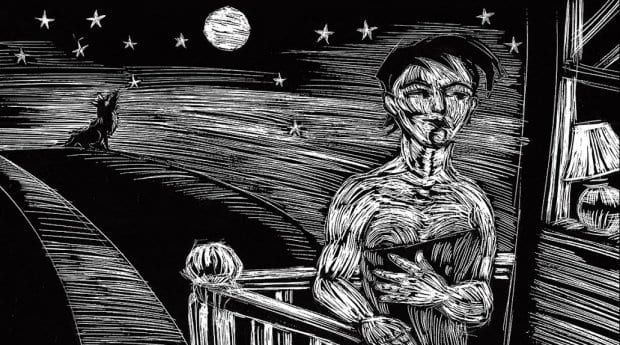Coming-of-age stories come in all formats and moods, but the recently published Motion Sickness by Ursula Pflug, with illustrations by SK Dyment, is a category of its own. A noir, surrealist tale of a young woman’s entry into adulthood includes a breaking and entering, an abortion, a dying parent, living on the dole, date-rape drugs, lousy sex, multiple acoustic and electronic guitars, square tomatoes and acres of gingham (don’t ask). Each 500-word chapter of Pflug’s evocative and wacky prose is accompanied by Dyment’s woodcut-style illustrations, painstakingly engraved on carbon scratchboards and preserved through digital scanning in high resolution.
The queer illustrator and graphic novelist — better known to his friends as Kismet — discovered Pflug’s writing one night by googling Patti Smith, which led him to a short story that Pflug had posted on her website. He emailed her, she emailed back, and the online friendship soon turned into a real-life collaboration after Pflug suggested that Dyment try his hand at illustrating some parts of the flash fiction project she was writing. He laboured over the scratchboards through the summer to develop an image for each of the chapters; when Pflug saw them, she decided to include the lot.
“I wanted a stark black-and-white contrast,” Dyment says. “I was interested in the medieval woodcut, and I looked at that and some contemporary artists who work in this format, too. What I find interesting about the woodcut is that there is a sort of constraint . . . when you look at medieval imagery, people can’t get out — they’re in a box and stuck, though they can be printed many times. I wanted to show a degree of containment of the imagery, and it’s an absolute reversal of the black on white. The images are contained, but they’re breaking free, too.” And they do indeed, in so many ways: his illustrations eschew the post-renaissance perspective, literalize some of the metaphors in Pflug’s text, operate in non-linear time, magnify the detail and minimize the prominent, and sometimes go for the naughty political winks of the kind that German Expressionism excelled at.
Leitmotifs are also detectable, and markers of Toronto appear discreetly here and there. Besides Toronto streetcars, readers will recognize some iconic Canadian buildings put through a dreamlike, slightly nightmarish prism. Then there’s humour. “I worked on some visual gags and details . . . I always search for an image that tells the story without imposing on Ursula’s writing.”
Now that the book is published, Dyment will continue working on his own projects. He recently completed a graphic novel, which he describes as “an eco-punk novel set in the ’40s, with dykes and trans men who are going through the ranch country of Canada and taking on the phosphate mining industry.” He’s also finished a work of adventure fiction with queer characters (“a motorcycle-filled romp with a lot of bank robbers”) and started a drawing project that will have him produce 25 drawings each day as an exercise in discipline and focus. “I like to draw pictures of people looking at pictures,” he says. “I like to look at the way their body sometimes strikes a pose they’re not aware of. It’s an interaction, looking at something; a connection different for everyone.”
Motion Sickness, by Ursula Pflug with illustrations by SK Dyment, is published by Inanna Publications.

 Why you can trust Xtra
Why you can trust Xtra


